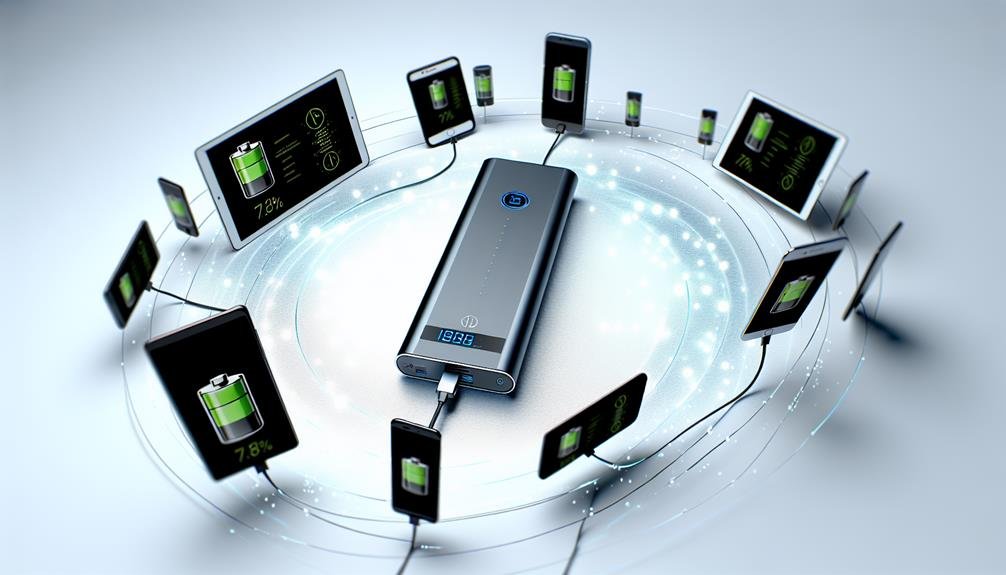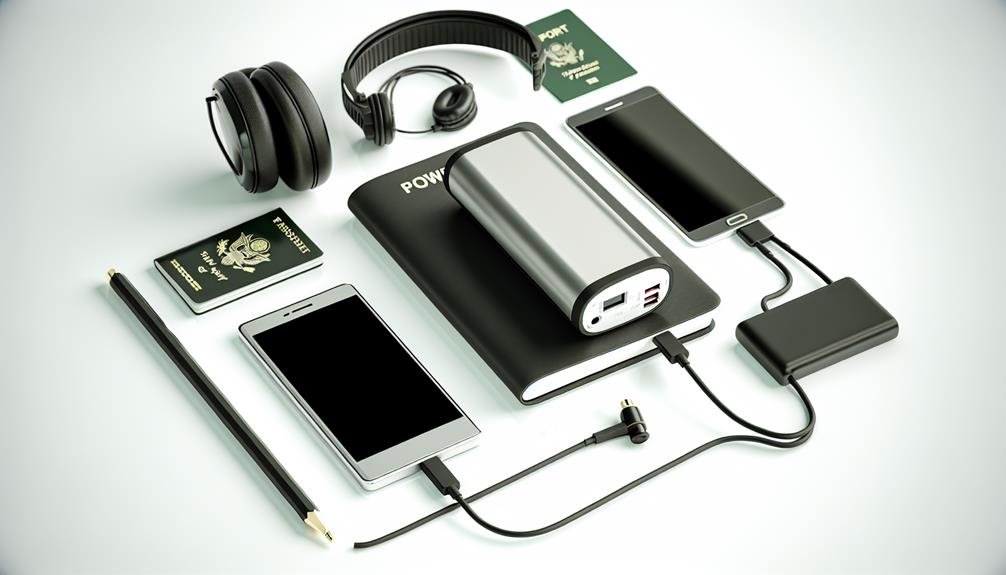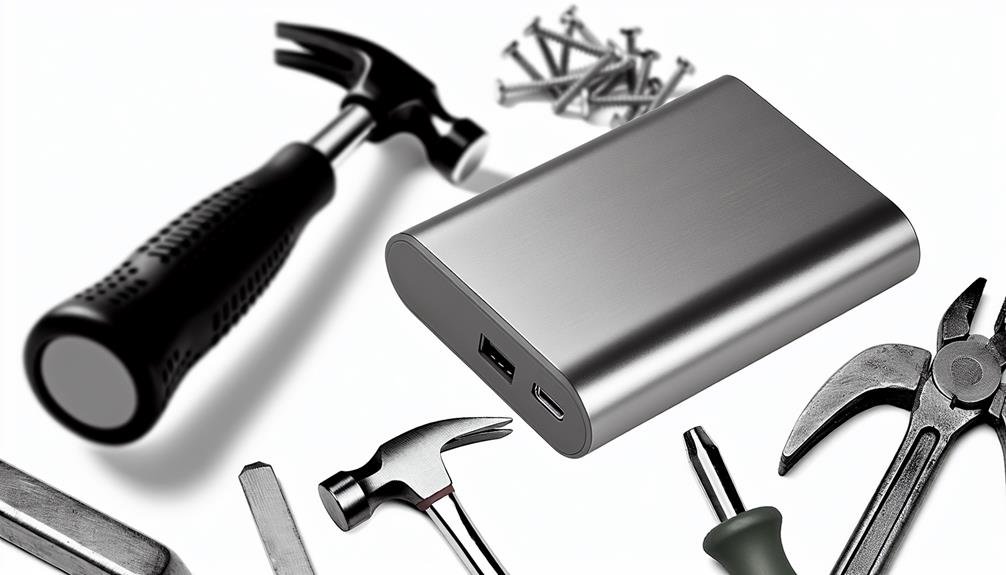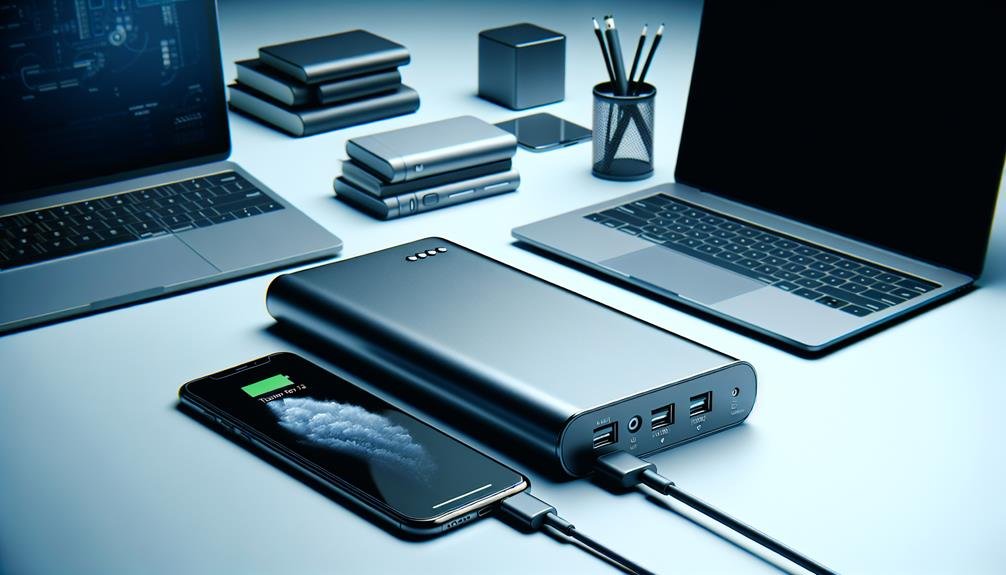When selecting a power bank, first consider the capacity in mAh; higher mAh means more recharges. Check the output rating for fast charging—volts and amperes are key. Validate compatibility by matching amperage and cable types with your devices. Portability is essential, so look for a balance between capacity and size. Build quality matters; opt for models with sturdy materials and safety certifications like CE or FCC. Extra features like integrated cables or LED indicators can enhance convenience. Prioritize reputable brands for safety and reliability. To explore more detailed aspects and make an informed choice, continue on.
Capacity and Battery Life

When selecting a power bank, you should first contemplate its capacity, usually measured in milliampere-hours (mAh), as it directly impacts how many times it can recharge your devices. A higher mAh rating means more recharges, but it also typically indicates a larger and heavier device.
For safety, it's important to compare brands, as reputable manufacturers often adhere to higher safety standards. Look into reviews and brand comparison guides to verify you're getting a product that won't overheat or malfunction. Price range can vary significantly; high-capacity power banks are often more expensive, but investing in a trusted brand can save you from potential hazards.
Size options are another aspect to ponder. Larger capacity power banks will naturally be bulkier, which might not be convenient for carrying around daily. Smaller units are more portable but offer fewer recharges. Also, check for charging indicators. These lights or displays show you the remaining battery life, assisting you in avoiding unexpected shutdowns.
Charging Speed
Charging speed is important because it determines how quickly your devices will be powered up, and this depends on the power bank's output rating, typically measured in volts (V) and amperes (A). To make sure you're getting the most efficient charging, look for fast charging options and power delivery features. These technologies provide higher output amperage, meaning your devices will charge faster and more efficiently.
When evaluating a power bank, check its maximum output amperage. A higher amperage, such as 2.4A or 3.0A, ensures quicker charging times. However, it's vital to match this with your device's input requirements to avoid any potential damage. Devices that support fast charging options like Qualcomm Quick Charge or USB Power Delivery (PD) can benefit significantly from a compatible power bank.
Equally important is the cable quality. A high-quality, certified cable can handle higher current levels and maintain charging speed, while a subpar cable may not support fast charging and could even pose safety risks.
Portability

A power bank's portability hinges on its size, weight, and design, making it important to balance between capacity and ease of carry. When selecting a power bank, consider the design options available. Slim, compact models are easier to slip into pockets or small bags, but they may offer less capacity compared to bulkier models. Weight considerations are pivotal; lighter power banks are more comfortable for everyday carry, especially if you'll be traveling or commuting frequently.
Size options range from ultra-compact units to larger, high-capacity models. While smaller units might be convenient, they often lack the power to charge multiple devices or provide multiple charges. On the other hand, larger units, though offering greater capacity, can become cumbersome.
To enhance portability while ensuring safety, look for convenience features such as:
- Integrated cables: Eliminates the need to carry extra cables.
- LED indicators: Quickly shows the charge level without guesswork.
- Rounded edges: Minimizes the risk of damage to your belongings.
Balancing these factors will allow you to select a power bank that's both portable and functional, ensuring you have power on the go without compromising safety or convenience.
Number of Ports
When evaluating the number of ports on a power bank, you'll want to factor in port compatibility and the types of devices you plan to charge. Different ports can vary in charging speed, affecting the efficiency of your charging sessions. Additionally, having multiple ports allows for simultaneous charging of multiple devices, which can be essential for productivity.
Port Compatibility Considerations
Considering the number of ports on a power bank is important, as it directly impacts how many devices you can charge simultaneously and the overall efficiency of your charging setup. When selecting a power bank, you'll want to assess the port compatibility to meet your specific needs.
First, check the port types and their compatibility with your devices. Modern power banks often come with a mix of USB-A, USB-C, and sometimes micro-USB ports. Evaluate the durability of these ports, especially if you'll frequently plug and unplug cables. Long-lasting ports can prevent the need for premature replacements.
Next, consider the output voltage and whether the ports support fast charging. Ports with higher output voltage can charge your devices faster, but it's crucial to make sure that your devices are compatible with these higher voltages to avoid any safety hazards.
Lastly, think about the number of ports relative to your usage needs:
- Charging multiple devices at once
- Compatibility with existing cables
- Port durability for frequent use
Make sure you have the proper cable lengths to avoid any strain or damage to the ports. Taking these factors into account will guarantee that your power bank is both efficient and safe to use.
Charging Speed Variations
Charging speed variations often hinge on the number of ports available on a power bank, as distributing power across multiple devices can impact the overall efficiency. When comparing charging speed, it's important to take into account the power bank sizes and how many devices you intend to charge simultaneously. A larger power bank with multiple ports may seem advantageous, but if the power distribution isn't optimized, you might notice slower charging speeds.
Quick charge technology is a game-changer in this situation. Power banks equipped with Quick Charge or similar technologies can greatly reduce charging times for compatible devices. However, the number of ports sharing this technology should be checked. Some power bank designs focus on aesthetics, offering sleek looks but compromising on the number of high-speed ports.
To ensure safety and top performance, look for power banks that allocate sufficient power to each port. For instance, if a power bank has two ports but only one supports quick charge, your overall charging speed will drop when both ports are in use. Always compare charging speed capabilities and make sure the power bank design aligns with your specific needs. Balancing these factors can help you select a power bank that offers both efficiency and safety.
Simultaneous Device Charging
Maximizing a power bank's utility and efficiency involves having an adequate number of ports to charge multiple devices simultaneously. When considering this aspect, focus on the quantity of output ports and their specifications. More ports enable you to charge multiple devices at the same time, but this also involves power sharing, which can impact the charging speed of each device.
To assist you in selecting the appropriate power bank, take into account the following:
- Device Prioritization: Some power banks feature intelligent power distribution, allowing specific devices to charge more quickly based on their power requirements and battery levels.
- Cable Management: Effective cable management is vital to prevent tangles and potential hazards. Seek out power banks that provide solutions to keep cables organized.
- Cable Length Restrictions: Shorter cables can minimize clutter but might restrict the placement of your device. Consider your typical usage scenarios to guarantee compatibility.
When utilizing a power bank with multiple devices, always verify the presence of overcharge protection and short-circuit prevention features to ensure safety. Moreover, prioritize power banks that can manage the collective power needs of your devices without overheating or diminishing battery life. By striking a balance between the number of ports and these considerations, you will discover a power bank that fulfills your requirements efficiently and securely.
Build Quality

When evaluating a power bank, one of the first aspects to scrutinize is its build quality, as this directly impacts durability and longevity. The materials used in the construction of a power bank play an essential role in its overall performance and safety. High-quality power banks often feature robust outer casings made from aluminum or high-grade plastic, which provide excellent protection against drops and impacts. Additionally, look for power banks with reinforced corners and a solid internal structure to further enhance durability.
Examine the fit and finish of the product. A well-built power bank will have no loose parts, gaps, or uneven surfaces. The buttons should feel firm and responsive, and the ports should be securely mounted. These details are indicators of good craftsmanship and attention to detail, which contribute to the device's long-lasting nature.
Furthermore, check for certifications such as CE, FCC, or RoHS, which guarantee that the power bank meets certain safety and quality standards. These certifications indicate that the product has undergone rigorous testing and is less likely to fail or cause harm. Always prioritize build quality to guarantee your power bank is safe, reliable, and long-lasting.
Compatibility
Understanding the compatibility of a power bank with your devices is crucial to guarantee efficient and seamless charging. Device compatibility is the cornerstone of selecting the right power bank. You need to check the power output specifications, ensuring they align with the requirements of your smartphone, tablet, or other gadgets. A power bank with insufficient output will fail to charge your devices properly, while one with excessive output could pose safety risks.
Cable compatibility is another integral aspect to take into account. Different devices require various types of cables, such as USB-A, USB-C, or Lightning. Confirm that the power bank supports the cables you use to optimize power efficiency and maintain safe charging practices. Using incompatible cables can lead to inefficient charging and potential damage to both the power bank and your device.
When assessing power banks, pay attention to:
- Power Output: Verify that the power bank's output matches your device's requirements to avoid undercharging or overcharging.
- Cable Types: Confirm that the power bank supports the necessary cables (USB-A, USB-C, Lightning) for your devices.
- Safety Features: Look for built-in protections like overcharge, short-circuit, and over-temperature safeguards to ensure secure operation.
Extra Features

Many power banks come with extra features that can greatly enhance their functionality and user experience. When evaluating these additional features, consider whether they align with your specific needs and preferences. For instance, some power banks offer built-in LED flashlights, which can be useful in emergencies. Others include wireless charging capabilities, eliminating the need for cables and providing a convenient charging solution for compatible devices.
Safety should be a top priority. Look for power banks with multiple safety protections, such as overcharge, over-discharge, and short-circuit protection. These features guarantee the device operates safely under various conditions. Additionally, some power banks come with auto-detect technology, which identifies the best charging speed for your device, enhancing both efficiency and safety.
Design aesthetics play a significant role in your selection process. A sleek, compact design not only looks good but is also practical for portability. Lastly, brand reputation is vital. Established brands often provide better customer support, warranties, and more reliable products. Investing in a reputable brand can save you from potential hazards and ensure a superior quality experience.
Frequently Asked Questions
Can a Power Bank Be Taken on an Airplane?
Imagine you're traveling with a 20,000mAh power bank. Airplane restrictions allow power banks under 100Wh in carry-on luggage. Always check travel regulations, as exceeding limits can lead to confiscation for safety reasons.
How Do I Properly Maintain My Power Bank?
To maintain your power bank, clean it regularly using a soft cloth and avoid harsh chemicals. For storage, keep it in a cool, dry place, and avoid extreme temperatures to guarantee safety and longevity.
Are Solar Power Banks Effective and Reliable?
Oh, sure, let's harness the sun's power, assuming you live in perpetual daylight! Solar power banks can be effective, but solar charging efficiency and durability concerns make them less reliable for consistent use. Prioritize safety and reliability.
What Are the Environmental Impacts of Using Power Banks?
Using power banks can increase your carbon footprint due to manufacturing and disposal processes. However, opting for models with recycling options minimizes environmental impact, ensuring safer and more sustainable practices. Always choose eco-friendly brands.
Do Power Banks Come With a Warranty?
While you're considering durability concerns, knowing that power banks typically come with warranty coverage is crucial. This is important for peace of mind, as it provides protection against defects and enhances safety for your devices.



